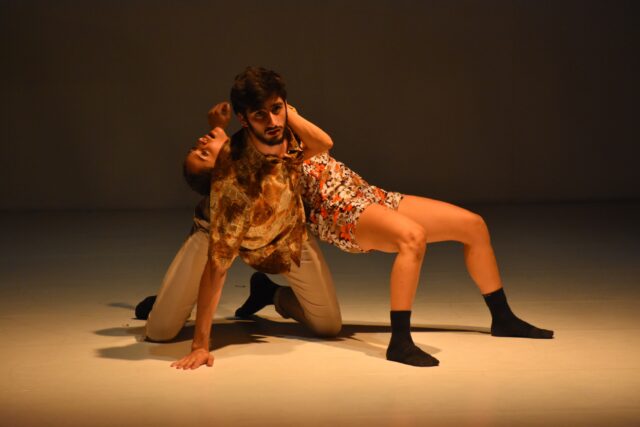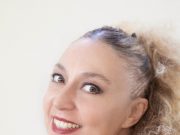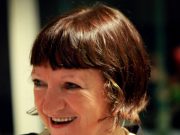
ROMA – Or Saadi, hai vinto con Striaes il premio Corpo Mobile 2023 durante il festival Corpo Mobile tenutosi al Teatrocittà di Roma e con la direzione artistica di Davide Romeo al Teatrocittà di Roma. Raccontami di quest’esperienza!
Dal primo momento in cui siamo entrati nel teatro e abbiamo incontrato l’organizzazione, Davide Romeo e il resto dello staff, abbiamo sentito subito una grande intimità. Era tutto molto accogliente, proprio come in Israele.
Ero curiosa di conoscere Teatrocittà e la sua storia unica, il quartiere nel quale si trova. Sentivo che le persone intorno a me erano veramente appassionate e che avrebbero affrontato il fuoco per realizzare i loro progetti. E questo mi ha davvero dato una grande ispirazione. Ho sentito un legame forte con tutti, perché anch’io mi sento così. L’arte, la danza, non è qualcosa che si sceglie, è quasi lei che sceglie te, e tu non puoi resistere e devi seguire. Poi con il tempo impari a realizzare ciò che devi fare. L’atmosfera del luogo e le persone di Corpo Mobile mi hanno fatto sentire che avevamo un linguaggio comune anche se eravamo sconosciuti l’uno all’altra.
“Ho sentito subito che stavamo facendo una bella performance”
Sei rimasta sorpresa della vittoria?
Ho sentito che abbiamo fatto un ottimo spettacolo. Quella sera, io e Shahar (Hanin ndr), il mio danzatore, siamo arrivati a un livello in cui abbiamo davvero lasciato che il pezzo prendesse vita attraverso di noi, senza forzare nulla. Ci siamo sentiti molto bene. La vittoria è stata la prova che il nostro legame artistico e performativo era di altissimo livello. Il premio è stato un riconoscimento del fatto che questo è il modo di fare arte.
“Dall’incontro con il pubblico ho capito che li avevamo emozionati”
Dopo lo spettacolo, abbiamo avuto il momento delle domande con la giuria e il pubblico e ho sentito un vero interesse. È stato toccante.
Vincere è stato sorprendente: il fatto che qualcuno ti veda e ti offra maggiori opportunità è straordinario, soprattutto per i giovani artisti. È per questo che si fa arte, per essere comunicativi e per essere in relazione con gli altri.
Uno dei commenti che abbiamo ricevuto è iniziato sottolineando che “la danza può essere molto astratta, al di fuori della vita”, ma ciò che mi interessa davvero è come si possa vedere l’umanità, i piccoli e delicati dettagli nella relazione tra due esseri umani che riflettono la vita di una persona. Non è necessario che sia grande, è il modo in cui si vedono le cose che lo rende rilevante…
Ho visto un film italiano durante i miei studi alla Open University di Israele, Umberto D. di Antonioni e c’è un’intera scena in cui il protagonista batte le palpebre. Ci sono infinite informazioni in quest’unica situazione che trasporta con sé molta immaginazione. Questo è anche ciò che voglio raggiungere quando danzo.
“IL mio processo creativo nasce dalle intuizioni”
Ricordo. Durante il momento delle domande sul processo creativo di Striaes, hai detto di partire da movimenti e gesti quotidiani. Ci parli del processo coreografico di Striaes e anche del processo di trasmissione con il tuo partner?
Ho creato il pezzo con Shahar 4 anni fa ed è stato il primo pezzo che ho creato. Ho iniziato a danzare tardi, avevo 22 anni. Abbiamo lavorato insieme nella stessa compagnia (Inbal Dance Company ndr). Un’idea era quella di creare coreografie fatte dai danzatori della compagnia. Non sapevo cosa fosse creare una danza, ma volevo farlo! Sai, ho intenzione di provare tutto quello che ha da fare con la danza perché la amo così tanto. E Shahar ha accettato di lavorare con me. Non avevo un metodo o una teoria, ma avevo le mie sensazioni, le mie intuizioni, il nostro legame di amicizia. Così all’inizio è stato un processo molto intuitivo. Abbiamo lavorato sulle differenze corporee tra le nostre dimensioni e i nostri generi. Eravamo in sala prove e ho iniziato a dire “proviamo questo” e da lì abbiamo cominciato.
Abbiamo lavorato sulla relazione tra un ragazzo e una ragazza; possono essere amanti, estranei, una famiglia. Abbiamo lavorato anche sull’età di entrambi in situazioni diverse: infanzia, età adulta, vecchiaia e stanchezza. Abbiamo poi lasciato il pezzo per 4 anni e l’abbiamo ripreso. Era qualcosa di diverso. Io ero diversa. Avevo bisogno di un nuovo processo per identificarmi di nuovo con il pezzo. Oggi non l’avrei creato in quel modo. Devo accettare che il pezzo è fuori di me, l’arte non è più legata a me, è indipendente.
Non è solo una performance, ma si tratta di osservare con molta attenzione, di ascoltare anche se si sussurra. Shahar è un ballerino davvero unico. Tutto ciò che fa è così speciale, sorprendente, diverso, fluido che ci ha permesso di giocare anche con i generi.
Hai detto che sei arrivata tardi alla danza, sono curiosa di sapere qual è il tuo background, dove hai incontrato la danza contemporanea, e quali sono le principali esperienze artistiche finora?
Provengo da una famiglia molto religiosa e in Israele non è comune per le ragazze ballare davanti a un pubblico. Mi sono sempre sentita amata, ma non mi sentivo completamente a mio agio, avevo molte domande senza risposte.
Dopo il servizio militare, ho viaggiato in Sud America e ho scoperto la salsa. Mi è piaciuta molto, così, tornata in Israele, ho iniziato a frequentare una scuola di danza vicino a casa mia e mi ci sono ritrovata 3 ore al giorno, tutti i giorni.
Era il momento di decidere cosa fare nella vita e mi sono detta che volevo diventare una ballerina professionista. Era molto ingenuo da parte mia. C’era molto da studiare. Ero in sala prove 10 ore al giorno, 7 giorni alla settimana. Ero veramente motivata. Ho studiato danza classica, contact improvisation, il repertorio della compagnia. Sono entrata nella compagnia Inbal, dove ho danzato per 4 anni, ed è diventata la mia seconda casa. L’arte mi ha davvero aiutato a sentirmi compresa. Questa è la realtà in cui voglio vivere, aperta e creativa, piena di domande.
“In Israele bisogna essere creativi anche nel trovare le risorse”
Può dirmi qualcosa sul sistema della danza in Israele e sulle opportunità, soprattutto per gli artisti emergenti?
Sono stata fortunata e sono entrata in una compagnia di danza molto buona sin dall’inizio della mia carriera. Dopo 4 anni, questo è il primo anno da freelance ed è molto difficile. Ci sono molti danzatori, Israele è un paese piccolo ed è difficile trovare lavoro. Anche dal punto di vista finanziario è difficile essere un artista in Israele. Il sostegno c’è, ma non è molto e non è sufficiente. Inoltre, non è facile andare in giro a fare audizioni, in Israele c’è la cultura di rimanere nel paese. Bisogna essere creativi anche nel trovare le risorse!
Grazie mille, Or, ci rivedremo quando tornerai presto in Italia!
Original text
Or Saadi, you have won the Corpo Mobile Award 2023 with the artistic direction of Davide Romeo at Teatrocittà in Rome with Striaes, tell me more about this experience!
From the first moment we walked into the theatre – not an ordinary theatre! – and we met the organization, Davide Romeo and the rest of the staff, we immediately felt closeness. The energy was warm and welcoming, just like in Israel.
I was curious about Teatrocittà and its unique story to change its original nature to make it a theatre. So I could feel the people around me were very passionate: they would go through fire to make things happen. So it really gavve me inspiration, it touched me. I felt the connection because I feel the same. Art, dance, is not something that you chose, it is almost it chooses you, And you cannot resist and you go for it. And you will learn through time how to do it and how to fulfill what you have to do. The atmosphere of the place and the people of Corpo Mobile made me feel we had a common language, even if we were new to each other.
Where you surprised to win?
I felt we had a very good show. Between me and Shahar (Hanin ndr), my dancer, that night, we got to a level in which we really let the piece be alive through us without forcing anything. We felt very good. Winning was proof that our artistic and performative connection was of a very high level. The prize was a recognition of the fact that this is the way to make art. After the show, we had question time with Jury and audience and I felt a real interest. This was touching.
Winning was amazing: the fact that someone sees you and offers you more opportunities – it is amazing especially for young artists. This is why you do art, to be communicative and to be in relation with others.
One of the comments we received was underlining that “dance can be very abstract, outside of life” but what really interests me is how you can see humanity, relationships, small delicate details of information between two humans. That reflects one’s life. It doesn’t need to be big, it is just how you can see things that make it relevant…
I saw an Italian movie in my studies at the Open University of Israel, Umberto D. by Antonioni and there is a whole scene in which the main character blinks. It was a lot of information in one single situation. It carries a lot of imagination. This is also what I want to reach when I perform.
I remember. During the question time about Striaes creative process, you mentioned starting from everyday movements and gestures. Tell me more about the choreographic process of Striaes and also the creative and transmission process with your dance partner.
I created the piece with Shahar 4 years ago and it was the first piece I ever created. I started dancing late, I was 22. I couldn’t resist it and we were together in the same company (Inbal ndr). One idea was to create choreographies by the company’s dancers for an evening. I didn’t know what it was to create a dance but I wanted to do it! You know, I am going to take whatever there is with the dance because I love it so much. And Chacha agreed to work with me. I did not have method or intellectual theories, but I had my feelings, my intuition, our connection as friends. So at the beginning it was a very intuitive process. We worked with the body differences between our sizes, our genders. We were in the studio and I started to say “let’s try this” and from there we continued. We worked on the relationship between a guy and a girl; they can be lovers, strangers, a family. We really worked also on what age both are in different situations: childhood, adulthood, old and tired. We left the piece for 4 years and after that we took it again and it was something different. I was different. I needed a new process to identify again with the piece. You know, today I would not have created it that way. I have to accept that the piece is outside of me, the art is not related to me anymore, it is independent in this world. When we came back on if, we worked on images, extra big, extra small, and how to fit with it. It is not only a performance but it is about looking at us very carefully, we want to be heard of even if we whisper. And Shahar is a very unique dancer. Everything he does is so special, surprising, different, fluid which allowed us to play with genders as well.
You said you arrived late to dance, I am curious to hear about your background, where did you encounter contemporary dance, what did you study and what are your main artistic experiences so far?
I come from a very religious family and it was not common for girls to dance in front of an audience in Israel. I always felt loved but I was not completely feeling that I fitted this place. I had a lot of questions without answers. After I did the army service, I traveled to South America and discovered salsa. I enjoyed it very much, so back in Israel I started to go to a dance studio next to my home, and I found myself there 3 hours a day, every day. It was the time to decide what to do in life so I said to myself I wanted to be a professional dancer. It was very innocent of me. I worked so hard in the studio: 10 hours a day, 7 days a week. I had the real motivation. Ballet, contact, the company repertoire, everything. I got into the Inbal dance company where I danced for 4 years, and it became my second home. The art really helped me to feel understood. This is the reality in which I want to live in, open and creative, full of questions.
Can you tell me something about the dance system in Israel and the opportunities, especially for emerging artists?
I was lucky and entered a very good dance company at the beginning of my career. After 4 years, this is the first year I am freelancing and it is very hard. There are a lot of dancers, Israel is a small country and it is hard to get jobs. Also financially, it is hard to be an artist in Israel. There is support but not a lot and not enough. Also, it is not so easy to go around and audition, there is a culture in Israel to stay in the country. You have to be creative in the way to find resources as well with this as well!
Thank you very much, Or, we will see you again when you come back to Italy!














































